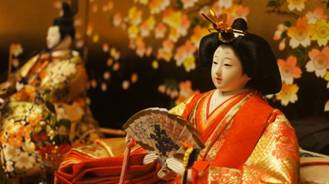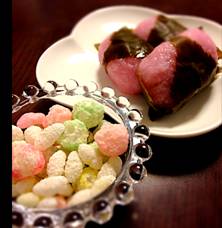
Winter cold has been subsided as seasons have been changing. In the bright sunshine, spring flowers of light colors make beautiful scenery. A new season also brings us new cultural and enjoyable events. After a new year holidays in January comes Setsubun, ‘Bean-Throwing’ Festival in February followed by Hina Matsuri, Dolls Festival in March.

In Japan, we have a custom to purify our soul, mind, and body and to wish for health at certain occasions during a year. The Seven-Herb Festival on January 7th, the Dolls Festival on March 3rd, the Feast of Flags (The Iris Festival) on May 5th, the Star Festival on July 7th, and the Chrysanthemum Festival on September 9th. Those 5 occasions are called ‘Sekku,” and among those, the Dolls Festival is to wish girls’ health and growth and also called Hina Dolls Festival after its main event of displaying the traditional Hina Dolls. (By the way, the Feast of Flags in May is for boys.)
The original custom of the doll festival was a bit different. People would rub a girl’s body with a paper doll shaped as a human as if to absorb all the bad spirits from her. Then, they would float it down the river to purify. The custom is called ‘Nagashi Bina’ and it is still practiced in some regions. But since the Edo period, the custom of decorating the hina dolls has taken the place of floating a paper doll. Though the shape of the hina doll has drastically changed, the concept stays the same. The hina doll is the girl’s alter ego, so it deserves to be treated as such. Materials used for the doll are very sensitive and the doll usually has kimono made with special fabric, so a great care must be paid when keeping the dolls in boxes. Also, when the dolls complete their duties and it’s time to be disposed, the owner of the doll or her mother must hold a memorial service properly.
In general, when a girl baby is born, parents on the maternal side give hina doll prior to the baby’s very first Dolls Festival. And the same dolls will be decorated and displayed every year until the baby is grown up. Some may take over their mothers’ dolls, but it is normal and basic for each girl baby gets her own doll set. However, such rule doesn’t necessarily apply to recent families because of the limited space within the house and the financial situations. Nowadays, hina dolls have a variety of types and sizes from which we can choose the best one for a girl baby.
Although the custom of Hina Matsuri has been modified accordingly, there is one customary manner that we need to follow. It is when to take out and when to put away the dolls. Hina Dolls are to display on a fine day soon after February 4th, ‘Rishun’ the first day of spring in the lunar calendar and they need to be put right away after March 3rd. It is just a superstitious but is believed that the girl may miss a good timing for getting married in the future if the dolls are not properly taken care of. The reasons behind this manner is that the doll taking bad spirits for the girl should not be displayed too long in public or the girl should be disciplined to keep things tidy and in order as growing up. Also, the Emperor and the Empress of the doll set reflects a wedding ceremony. Japanese phrase, ‘katazuku,’ has dual meanings of putting away and being married off, so there includes a parents’ wish that their daughter will get married accordingly.

I don’t have a daughter but we spent the night of Dolls Festival with Hina arare that my younger son brought home from kindergarten and sakura mochi.
Hina Dolls are usually decorated with peach blossoms, hina arare (sweetened rice-flour cakes), hishi mochi (rhombus-shaped rice pounded cake), and sweet drink made from fermented rice. The four colors of hina arare, pink, green, yellow, and white represent four seasons. Hishi mochi has three layers of pink, white, and green; each of which means talisman, purity, and longevity. Family having girl children usually celebrates Dolls Festival with chirashi sushi, unrolled sushi served in a box and clear soup of clams on the night of March 3rd. Clams symbolize a perfect couple as it requires them a couple of shells to close tightly. Serving a clam soup on Hina matsuri is a hidden prayer that parents wish for their daughter to be blessed with a good match in the future.
